1993 BUICK PARK AVENUE horn
[x] Cancel search: hornPage 14 of 340
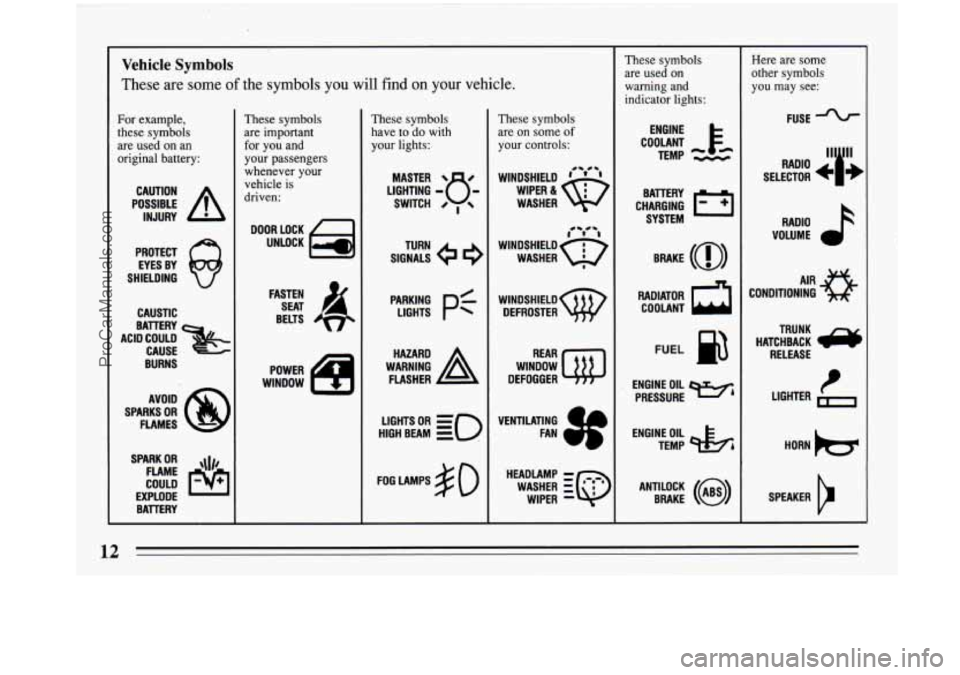
!
!
Vehicle Symbols
These are some of the symbols you will find on your vehicle.
For example,
these symbols
are used on an
original battery:
POSSIBLE A
CAUTION
INJURY
PROTECT
EYES BY
SHIELDING
CAUSTIC
ACID COULD BATTERY
CAUSE
BURNS
SPARK
OR ,\I/,
COULD FLAME
EXPLODE BATTERY
These symbols are important
for you and
your passengers
whenever your
vehicle is
driven:
DOOR LOCK
UNLOCK
FASTEN SEAT
4
BELTS
POWER
WINDOW
These symbols have to do with
your lights:
LIGHTS PC
HIGH BEAM OR = =o
FOG LAMPS $0
These symbols
are on some
of
your controls:
WINDSHIELD ' ' '
WASHER
l0 'r' -1
WINDSHIELD 6$
WASHER 8
WINDSHIELD
DEFROSTER
WINDOW
DEFOGGER
VENTILATING FAN
3f
HEADLAMP -
WIPER -
WASHER iQ
These symbols
are used on
warning and
indicator lights:
COOLANT F-
TEMP --
ENGINE
RADIATOR
a
COOLANT
FUEL
ENGINE OIL wb
PRESSURE
TEMP
OIL &4
ANTILOCK (a)
BRAKE
Here are some
other symbols
you may see:
FUSE
RADIO
>
VOLUME
HATCHBACK
e
TRUNK
RELEASE
LIGHTER
1-1
HORN )tr
SPEAKER
b
ProCarManuals.com
Page 73 of 340
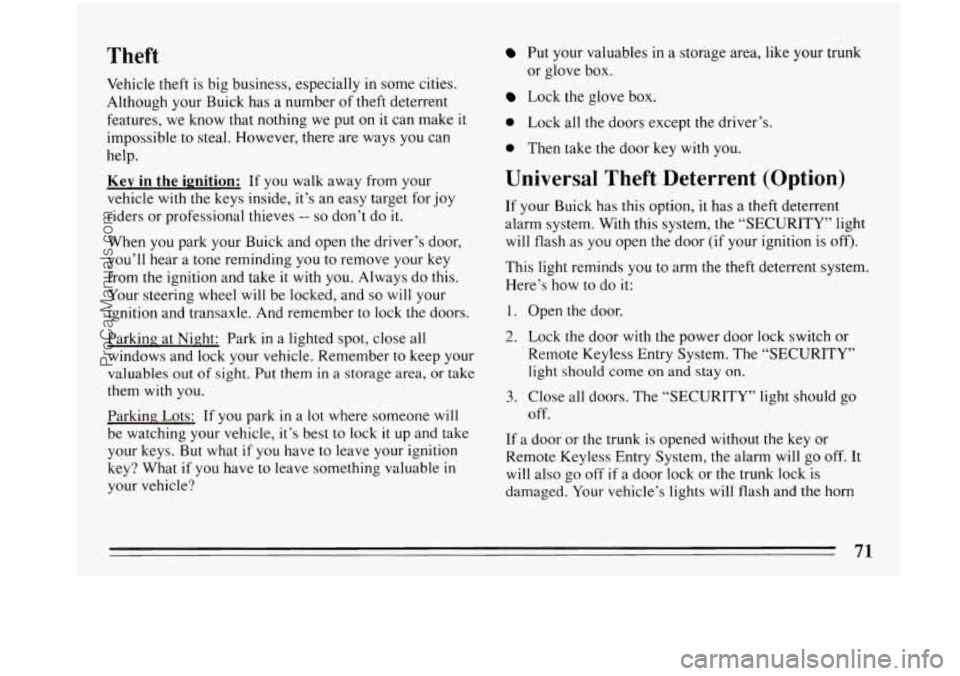
Theft
Vehicle theft is big business, especially in some cities.
Although your Buick has a number of theft deterrent
features, we know that nothing we put on
it can make it
impossible to steal. However, there are ways you can
help.
Kev in the ignition: If you walk away from your
vehicle with the keys inside, it’s an easy target for joy
riders or professional thieves
-- so don’t do it.
When you park your Buick and open the driver’s door,
you’ll hear a tone reminding you to remove your key
from
the ignition and take it with you. Always do this.
Your steering wheel will be locked, and
so will your
ignition and transaxle. And remember to lock the doors.
Parking at Night: Park in a lighted spot, close all
windows and lock your vehicle. Remember
to keep your
valuables
out of sight. Put them in a storage area, or take
them with you.
Parking. Lots: If you park
in a lot where someone will
be watching your vehicle, it’s best to lock
it up and take
your keys. But what if you have
to leave your ignition
key? What if you have to leave something valuable
in
your vehicle?
Put your valuables in a storage area, like your trunk
Lock the glove box.
or glove
box.
0 Lock all the doors except the driver’s.
0 Then take the door key with you.
Universal Theft Deterrent (Option)
If your Buick has this option, it has a theft deterrent
alarm system. With this system, the “SECURITY’’ light
will flash as
you open the door (if your ignition is off).
This light reminds you
to arm the theft deterrent system.
Here’s how to do it:
1. Open the door.
2. Lock the door with the power door lock switch or
Remote Keyless Entry System. The “SECURITY”
light should come on
and stay on.
3. Close all doors. The “SECURITY” light should go
off.
If a door or the trunk is opened without the key or
Remote Keyless Entry System, the alarm will
go off. It
will also
go off if a door lock or the trunk lock is
damaged. Your vehicle’s lights will flash and the horn
71
ProCarManuals.com
Page 74 of 340
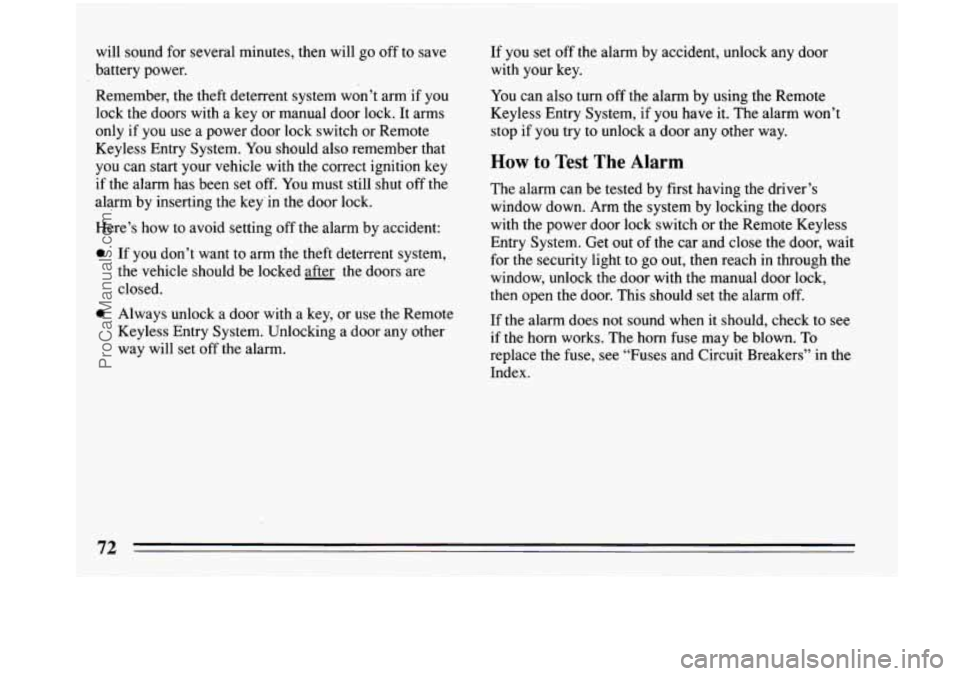
will sound for several minutes, then will go off to save
battery power.
Remember, the theft deterrent system won’t arm if you
lock
the doors with a key or manual door lock. It arms
only if you use
a power door lock switch or Remote
Keyless Entry System. You should also remember that
you can start your vehicle with the correct ignition key
if the alarm has been set
off. You must still shut off the
alarm by inserting the key’in the door lock.
Here’s how to avoid setting
off the alarm by accident:
0
0
If you don’t want to arm the theft deterrent system,
the vehicle should be locked after the doors are
closed.
Always unlock a door with’a key, or use the Remote
Keyless Entry System. Unlocking a door any other
way will set
off the alarm. If
you set
off the alarm by accident, unlock any door
with your
key.
You can also turn off the alarm by using the Remote
Keyless Entry System,
if you have it. The alarm won’t
stop
if you try to unlock a door any other way.
How to Test The Alarm
The alarm can be tested by first having the driver’s
window down. Arm
the system by locking the doors
with the power door lock switch or the Remote Keyless
Entry System. Get out
of the car and close the door, wait
for the security light to go out, then reach in through the
window, unlock the door with the manual door lock,
then open the door. This should set the alarm off.
If the alarm does not sound when
it should, check to see
if the horn works. The horn fuse may be blown. To
replace the fuse, see “Fuses and Circuit Breakers” in the
Index.
72
ProCarManuals.com
Page 92 of 340
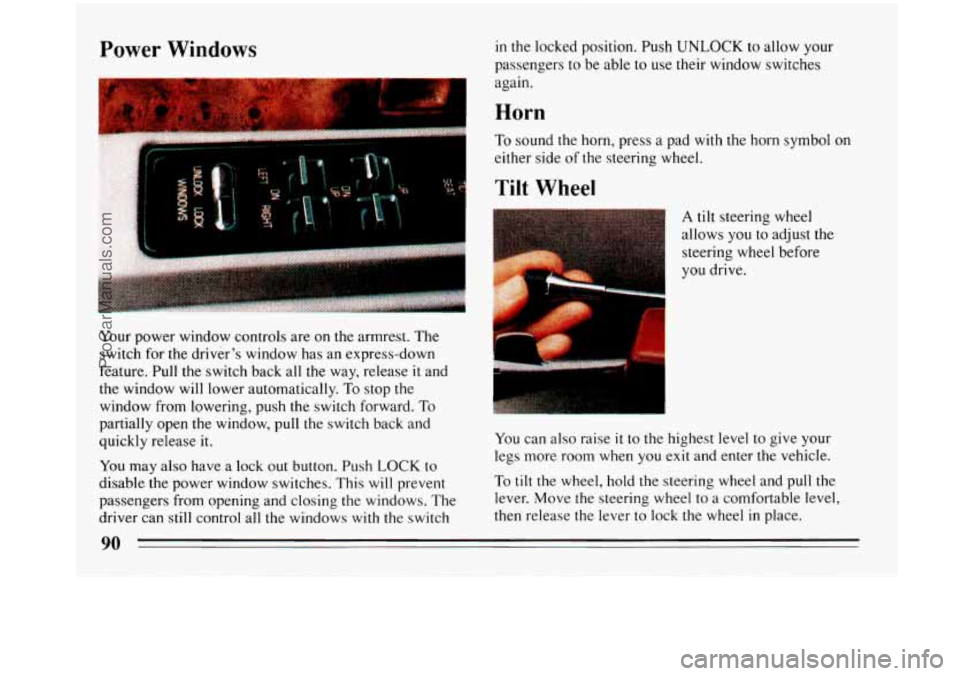
Power Windows
I
Your power window controls are on the armrest. The
switch for the driver’s window has an express-down
feature. Pull the switch back all
the way, release it and
the window will lower automatically.
To stop the
window from lowering, push the switch forward.
To
partially open the window, pull the switch back and
quickly release it.
You may
also have a lock out button. Push LOCK to
disable the power window switches. This will prevent
passengers
from opening and closing the windows. The
driver can still control all the windows
with the switch
in the locked position. Push UNLOCK to allow your
passengers to be able to use their window switches
again.
Horn
To sound the horn, press a pad with the horn symbol on
either side
of the steering wheel.
Tilt Wheel
i
I
A tilt steering wheel
allows you to adjust the
steering wheel before
you drive.
You can also raise it to the highest level to give your
legs more room when
you exit and enter the vehicle.
To
tilt the wheel, hold the steering wheel and pull the
lever. Move the steering wheel to
a comfortable level,
then release the lever to lock
the wheel in place.
ProCarManuals.com
Page 181 of 340
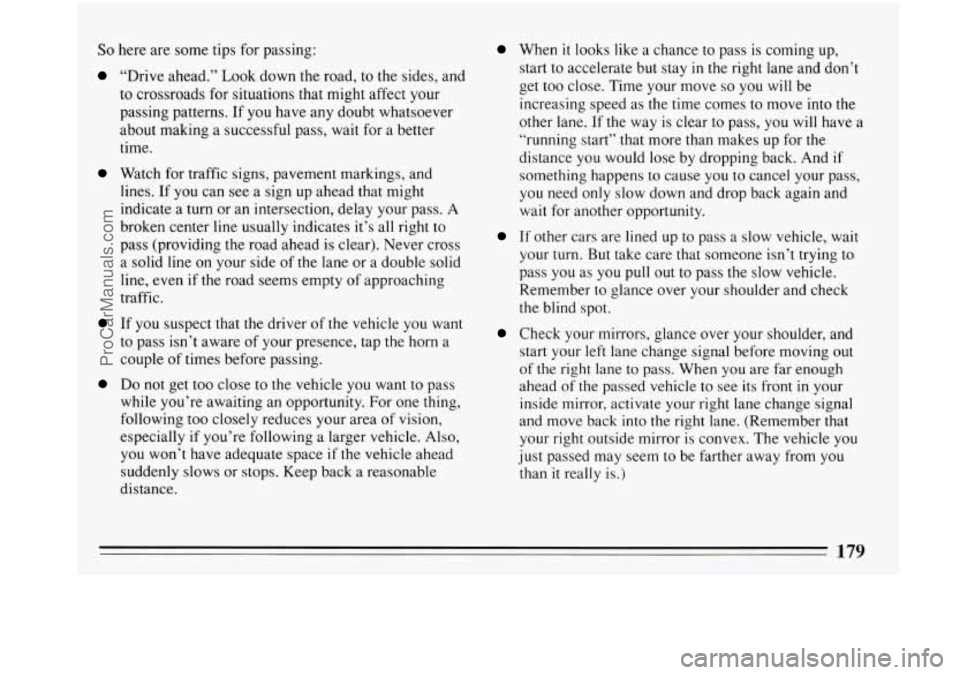
So here are some tips for passing:
“Drive ahead.” Look down the road, to the sides, and
to crossroads for situations that might affect your
passing patterns.
If you have any doubt whatsoever
about making a successful pass, wait for a better
time.
Watch for traffic signs, pavement markings, and
lines. If you can see a sign up ahead that might
indicate a turn or an intersection, delay your pass. A
broken center line usually indicates it’s all right to
pass (providing the road ahead is clear). Never cross
a solid line
on your side of the lane or a double solid
line, even if the road seems empty of approaching
traffic.
If you suspect that the driver of the vehicle you want
to pass isn’t aware of your presence, tap the
horn a
couple of times before passing.
Do not get too close to the vehicle you want to pass
while you’re awaiting an opportunity. For one thing,
following
too closely reduces your area of vision,
especially if you’re following
a larger vehicle. Also,
you won’t have adequate space if the vehicle ahead
suddenly slows or stops. Keep back a reasonable
distance.
When it looks like a chance to pass is coming up,
start to accelerate but stay in the right lane and don’t
get too close. Time your move
so you will be
increasing speed as
the time comes to move into the
other lane. If the way is clear to pass, you will have a
“running start’’ that more than makes up for the
distance you would lose by dropping back. And if
something happens to cause you to cancel your pass,
you need only slow down and drop back again and
wait for another opportunity.
If other cars are lined up to pass a slow vehicle, wait
your turn.
But take care that someone isn’t trying to
pass you as you pull out to pass the slow vehicle.
Remember to glance over your shoulder and check
the blind spot.
Check your mirrors, glance over your shoulder, and
start your
left lane change signal before moving out
of the right lane to pass. When you are far enough
ahead of the passed vehicle
to see its front in your
inside mirror, activate your right lane change signal
and move back into the right lane. (Remember that
your right outside mirror
is convex. The vehicle you
just passed may seem to be farther away from you
than it really
is.)
ProCarManuals.com
Page 189 of 340
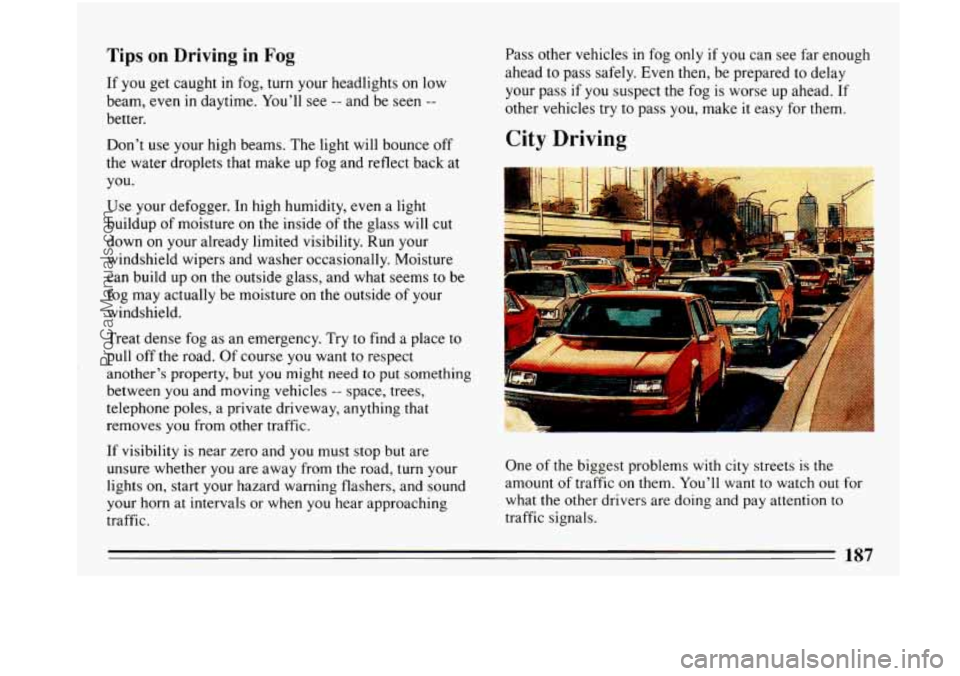
Tips on Driving in Fog
If you get caught in fog, turn your headlights on low
beam, even
in daytime. You’ll see -- and be seen --
better.
Don’t
use your high beams. The light will bounce off
the water droplets that make up fog and reflect back at
you.
Use your defogger. In high humidity, even a light
buildup of moisture on the inside of the glass will cut
down on your already limited visibility.
Run your
windshield wipers and washer occasionally. Moisture
can build up on the outside glass, and what seems to be
fog may actually be moisture
on the outside of your
windshield.
Treat dense fog as an emergency. Try to find a place
IO
pull off the road. Of course you want to respect
another’s property, but you might need
to put something
between you and moving vehicles
-- space, trees,
telephone poles, a private driveway, anything that
removes
you from other traffic.
If visibility is near zero and
you must stop but are
unsure whether you are away from the road, turn your
lights on, start your hazard warning flashers, and sound
your horn at intervals or when you hear approaching
traffic. Pass
other vehicles in fog only if you
can see far enough
ahead to pass safely. Even then, be prepared to delay
your pass if you suspect the fog is worse up ahead.
If
other vehicles try to pass you, make it easy for them.
City Driving
L
One of the biggest problems with city streets is the
amount
of traffic on them. You’ll want to watch out for
what
the other drivers are doing and pay attention to
traffic signals.
187
ProCarManuals.com
Page 328 of 340
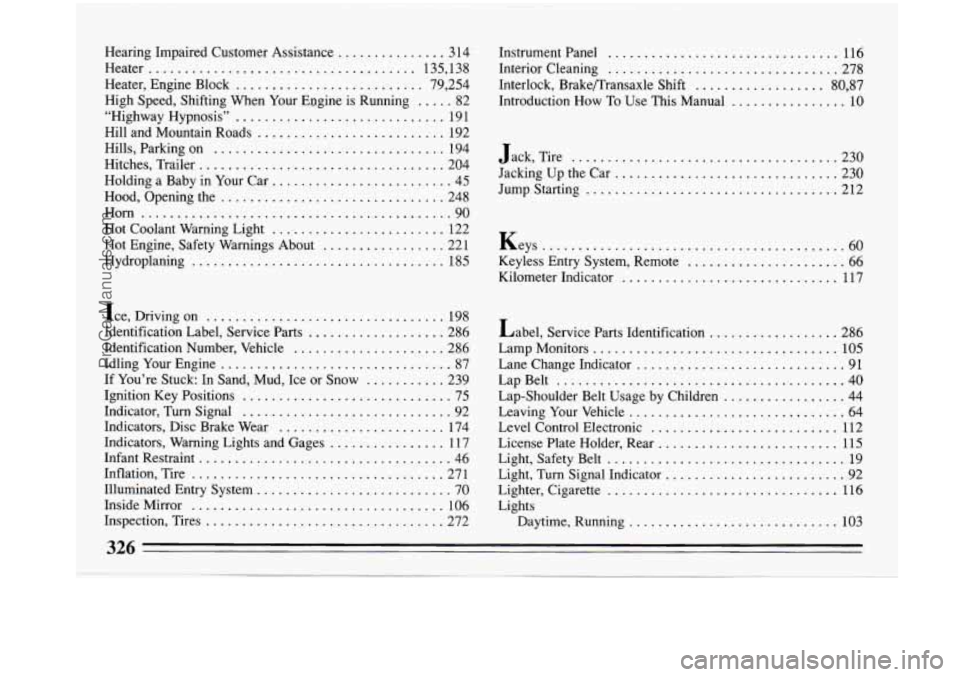
Hearing Impaired Customer Assistance ............... 3 14
Heater
..................................... 135. 138
Heater. Engine Block
.......................... 79. 254
High Speed. Shifting When Your Eogine is Running
..... 82
“Highway Hypnosis’’
............................. 19 1
Hill and Mountain Roads
.......................... 192
Hills. Parking on
................................ 194
Hitches. Trailer
.................................. 204
Holding a Baby
in Your Car ......................... 45
Hood. Opening the
............................... 248
Horn
........................................... 90
Hot Coolant Warning Light
........................ 122
Hot Engine. Safety Warnings About
................. 221
Hydroplaning
................................... 185
Ice. Driving on
................................. 198
Identification Label. Service Parts
................... 286
Identification Number. Vehicle
..................... 286
Idling Your Engine
................................ 87
If You’re Stuck: In Sand. Mud. Ice or Snow ........... 239
Ignition Key Positions
............................. 75
Indicator. Turn Signal
............................. 92
Indicators. Disc Brake Wear
....................... 174
Indicators. Warning Lights and Gages
................ 117
Infant Restraint
................................... 46
Inflation. Tire
................................... 271
Illuminated Entry System
........................... 70
Inside Mirror ................................... 106
Inspection. Tires
................................. 272 Instrument Panel
................................ 1 16
Interior Cleaning
................................ 278
Interlock. BrakeRransaxle Shift
.................. 80. 87
Introduction How
To Use This Manual ................ 10
J ack. Tire ..................................... 230
Jacking Up the Car
............................... 230
Jump Starting
................................... 212
Keys
.......................................... 60
Keyless Entry System. Remote ...................... 66
Kilometer Indicator
.............................. 117
Label. Service Parts Identification
.................. 286
Lamp Monitors
.................................. 105
Lane Change Indicator
............................. 91
Lap-Shoulder Belt Usage by Children
................. 44
Leaving Your Vehicle
.............................. 64
Level Control Electronic
.......................... 112
License Plate Holder, Rear
......................... 115
Light, Safety Belt
................................. 19
Light, Turn Signal Indicator
......................... 92
Lighter, Cigarette
................................ 116
Daytime. Running
............................. 103
LapBelt
........................................ 40
Lights
ProCarManuals.com